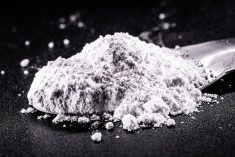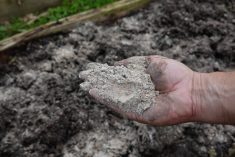Since my retirement from Alberta Agriculture in 2002 I’ve acted as a legal expert in a number of lawsuits. Often, when a farmer is sued by a lawyer on behalf of a client, the farmer will immediately seek his own lawyer or lawyers for advice. While the lawyer may be well apprised of provincial and federal legal systems, many know little about the facts of agriculture and can lack the expertise to ask the litigant or litigants the appropriate questions.
In one suit, for example, brought by a farmer against a chemical sales company, herbicide contamination was alleged to have resulted in significant crop loss. The farmer even had a purported expert company that backed up his claims of crop loss.
I was hired by the defendant’s lawyer a couple of years or so into the litigation. This suit claimed the litigant farmer seeded several hundred acres of yellow mustard and the expected crop was a write-off due to herbicide contamination. But when I got to analyze the depositions by the litigant farmer, I unearthed the following:
Read Also

Gentle treatments for pain in the neck
Heading toward year-end, people unknowingly tense up against the cold and busyness, causing neck pain that can often be treated with appropriate support and gentle mobility, athletic therapist Kathlyn Hossack says.
- He expected a yield of 35 bushels of yellow mustard per acre. The average yellow mustard yield on the Prairies is around 15-17 bushels per acre.
- He had never, according to his farm records, even grown mustard previously.
- The barley yield the previous season on this mustard cropland was four bushels per acre.
- The litigant farmer had no record of applying any fertilizer to the cropland for at least 10 years.
- There were no records of any soil tests on the cropland.
If the lawyer and defendant had agreed to hire a seasoned agronomist at the onset of the litigation, the lawsuit could have been settled years sooner.
In another case, organic growers were suing several farmers, alleging glyphosate drift damaged their organic pea crops. In every instance there was a road allowance (20 metres, or 66 feet) between the defendants’ and litigants’ fields. The litigants even stated they could smell the glyphosate. Glyphosate is a salt and has no smell. Anyway, this lawsuit was so full of holes you could have driven a truck through it. I had lots of other examples.
Nevertheless, even after being shown their allegations are groundless, individuals can and do instigate lawsuits claiming millions of dollars in losses. An insurance company may still opt for a percentage settlement rather than the cost of a drawn-out legal process.
Perceptions and realities
Glyphosate, for one, has been a target for dubious lawsuits and claims because of its agronomic success. We can thank this herbicide primarily for the elimination of perennial grass infestations, such as quackgrass, from our cropland. This has resulted in the virtual elimination of destructive fungal diseases, such as take-all and snow mould, both of which need perennial grasses to survive on cropland from season to season — an unexpected positive consequence of herbicide application.
The insecticide DDT, for another example, continues to be vilified as the alleged cause of eggshell thinning in falcons and bald eagles years ago. The basis of this eggshell thinning was very sketchy and inconsistent. What these vocalists forget is that DDT has saved countless millions of human lives, particularly those who could have died from malaria.
Since 2000, malaria is estimated to have infected over 225 million people worldwide per year, resulting in over 500,000 deaths annually, mostly in Africa. The World Health Organization (WHO) in 2006 announced its support for use of DDT indoors for mosquito control in several countries.
The reason I bring this up is that DDT’s time as an agricultural pesticide has come and gone. What I object to is the frequently-quoted question of raptor eggshell thinning versus the saving of countless millions of human lives. DDT is also primarily responsible for elimination of malaria in both North America and Europe.
Feeding frenzies
Another misconception is the attention given to foliar feeding. Foliar feeding of micronutrients, such as zinc, copper, manganese and molybdenum, has been shown to be effective in field and horticultural crop deficiencies. Foliar feeding with macronutrients, however, is another story.
If you are growing wheat, corn, canola or potatoes you apply the bulk of nutrients needed at or prior to seeding. If growing conditions improve significantly in a given year, you can consider applying additional nitrogen, perhaps phosphate or sulphur. The additional nutrients could be applied via irrigation or drip-fed during the growing season.
Applying macronutrients to crop foliage, though, does not really work, since a plant’s leaves can only take in a few pounds per acre of nitrogen at most. The bulk of the foliar spray runs down the plant leaves and stems, or perhaps sits on the foliage. If it rains or the soil is good and moist, the bulk of this foliar application is taken up by the crop roots on or just below the soil surface. If the soil surface is dry and there is no rain in the next few weeks, these foliar macronutrients do not get in the crop; they get stranded.
Read your product labels — yes, read them. I have actually seen farmers and colonies buy quantities of 10-litre jugs of products and for practical purposes there is nothing in the jug — perhaps a touch of nitrogen or phosphate, but with no published research or ongoing field trials to back up their use.
If a product is sold in Canada, Agriculture and Agri-Food Canada requires that all ingredients, either liquid or powder, must be displayed on the label, as well as the percentage of each ingredient. So, what is one per cent nitrogen in a 10-litre jug going to do to a crop, at a recommended application rate of 10 c.c. an acre? I know of farmers and colonies who have bought truckloads of so-called nutrient jugs.
Trace elements
Remember some 15 years ago when over 100 or so farmers, at $50,000 a pop, purchased contraptions that pushed tractor exhaust into their seeding equipment? Many Prairie scientists stated this exhaust system did little or nothing for fertility, since the tractor fuel contained only trace amounts of crop macronutrients. There was no substantial research, other than testimonials. The concept was based on belief, not fact. Crops need fixed amounts of N, P, K and S to achieve target yields, no ifs or buts.
My only regret in this instance is that I did not take a photograph of one of these contraptions. The seller in this instance was sincere in the belief that the system worked, but over time it could be shown it had no factual basis in enhancing cropland fertility.
















